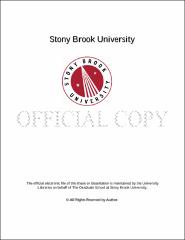| dc.identifier.uri | http://hdl.handle.net/11401/76697 | |
| dc.description.sponsorship | This work is sponsored by the Stony Brook University Graduate School in compliance with the requirements for completion of degree. | en_US |
| dc.format | Monograph | |
| dc.format.medium | Electronic Resource | en_US |
| dc.language.iso | en_US | |
| dc.publisher | The Graduate School, Stony Brook University: Stony Brook, NY. | |
| dc.type | Dissertation | |
| dcterms.abstract | The coherent electron cooling is a novel hadron beam cooling technique that is being developed at Brookhaven National Laboratory. It is a realization of the stochastic cooling, in which an electron beam is used in the modulator, amplifier and kicker. In the modulator, hadrons create electron density perturbations. Then these perturbations are amplified in the free electron laser, while hadrons pass through dispersion section, where they are placed such that, in the kicker, amplified perturbations' electric fields accelerate or decelerate hadrons, depending on their velocities, cooling the beam. In the present dissertation, we describe ways to model the modulator section of the coherent electron cooling. The electron beam can be modeled as an infinite plasma and in this model even analytical solutions can be obtained for the density perturbations. Obviously, infinite electron plasma is unrealistic model of an electron beam in accelerator. The main result of the dissertation is a method to compute dynamics of shielding of a moving charged particle (hadron) in a confined plasma, which represents a realistic model of an electron beam. This is a longstanding problem in plasma physics with applications ranging from cosmology to advanced particle accelerator techniques. However, only solutions for an infinite unrealistic plasma are available. We developed a novel method to solve this problem, which consists of transformation of the Vlasov-Poisson differential equations to an integral equation for the Laplace image of the electron density perturbation created by an external charge. The integral equation is then solved numerically via the piecewise polynomial collocation method and the fast Fourier transform. We present thorough analysis of the results obtained and their physical interpretation. We also consider infinite plasma model and derive some formulas for the free electron laser section within this approximation. | |
| dcterms.available | 2017-09-20T16:51:00Z | |
| dcterms.contributor | Kharzeev, Dmitri | en_US |
| dcterms.contributor | Litvinenko, Vladimir | en_US |
| dcterms.contributor | Hemmick, Thomas | en_US |
| dcterms.contributor | Aschenauer, Elke-Caroline. | en_US |
| dcterms.creator | Elizarov, Andrey | |
| dcterms.dateAccepted | 2017-09-20T16:51:00Z | |
| dcterms.dateSubmitted | 2017-09-20T16:51:00Z | |
| dcterms.description | Department of Physics. | en_US |
| dcterms.extent | 133 pg. | en_US |
| dcterms.format | Monograph | |
| dcterms.format | Application/PDF | en_US |
| dcterms.identifier | http://hdl.handle.net/11401/76697 | |
| dcterms.issued | 2015-12-01 | |
| dcterms.language | en_US | |
| dcterms.provenance | Made available in DSpace on 2017-09-20T16:51:00Z (GMT). No. of bitstreams: 1
Elizarov_grad.sunysb_0771E_12251.pdf: 5225809 bytes, checksum: 95e41532267b2dd2c3644b0c3a3f0dce (MD5)
Previous issue date: 1 | en |
| dcterms.publisher | The Graduate School, Stony Brook University: Stony Brook, NY. | |
| dcterms.subject | Physics | |
| dcterms.title | Advances in Theory of Coherent Electron Cooling | |
| dcterms.type | Dissertation | |

